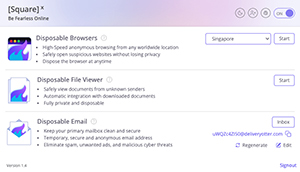Vivek Ramachandran, Founder & CEO
Vivek Ramachandran, a seasoned veteran with over 20 years in cybersecurity, has been attuned to these consumer security challenges. He recognized the issue as not an absence of advanced cybersecurity tools but rather an overlooked, yet crucial, gap in system defenses, which led him to establish SquareX.
SquareX leverages the concept of disposable browsing to address the longstanding tension between cybersecurity and user productivity. Its browser extension facilitates secure web interactions by creating isolated, gigabit-speed browsing sessions.
This technique serves as a practical application of the zero-trust security model. Any malicious code encountered during the disposable browsing session is confined to a secure, sandboxed environment on SquareX’s cloud servers, eliminating the risk to the onsite system.
An equally important aspect of cybersecurity is anonymity—often referred to as the first line of defense. SquareX acknowledges this by maintaining privacy throughout the session and purging all the data post-session, which are vital for avoiding targeted attacks based on user behavior analytics.
“Year upon year, as cyber threats escalate, businesses lose billions of dollars to attacks, phishing schemes, and scams. Our solution is designed to play a disruptive role in turning the tide,” says Ramachandran, founder and CEO of SquareX.

Its efficacy is rooted in the principle of simplicity. Conventional cybersecurity solutions primarily rely on access-blocking models, which, while safeguarding users, unfortunately, compromises productivity. For example, a user receiving a Word document from a recruiter might find the file flagged as potentially malicious by their antivirus software. The dilemma is apparent—either adhere to the antivirus warning and forgo viewing the document or turn off security protocols to access potentially crucial information.
SquareX is a salient departure from this established norm by employing a 100 percent deterministic security model. It ensures unequivocal assessments of potential threats and maintains productivity.
The browser also has built-in automatic ad and tracker blocking. This enhances the user experience by reducing page load times and protecting against invasive tracking algorithms.
Its efficacy is rooted in the principle of simplicity. Conventional cybersecurity solutions primarily rely on access-blocking models, which, while safeguarding users, unfortunately, compromises productivity. For example, a user receiving a Word document from a recruiter might find the file flagged as potentially malicious by their antivirus software. The dilemma is apparent—either adhere to the antivirus warning and forgo viewing the document or turn off security protocols to access potentially crucial information.
Complicating the situation are the cybersecurity tools working on probabilistic models for threat detection. The same file could show different assessments from different security solutions like Norton Antivirus and Microsoft Defender, leading to user confusion in determining potential security risks.SquareX is a salient departure from this established norm by employing a 100 percent deterministic security model. It ensures unequivocal assessments of potential threats and maintains productivity
SquareX is a salient departure from this established norm by employing a 100 percent deterministic security model. It ensures unequivocal assessments of potential threats and maintains productivity.
The browser also has built-in automatic ad and tracker blocking. This enhances the user experience by reducing page load times and protecting against invasive tracking algorithms.
SquareX can also be effectively used for disposable file viewing and creating temporary email addresses. For instance, instead of downloading potentially infected documents on a system, users can access them safely on SquareX’s servers, eliminating the need to disable existing antivirus software or compromise their local system security. The temporary email addresses, on the other hand, can be used to sign up for platforms, receive an activation email, and complete the registration process—all without divulging users’ personal email addresses.

Recently, a recruitment firm used its disposable browser and document viewer to engage with documents from unfamiliar sources. By operating within SquareX’s secure cloud environment, the recruiter shielded itself from potential security threats. This seamless integration with the existing web browser interface increased their productivity without having to acclimate to a new workflow or a product.

Developing a security product as innovative as SquareX requires a deep commitment to R&D. A notable strategy in this regard was the company’s early adoption of a bug bounty program. By inviting ethical hackers to probe the system for vulnerabilities and offering significant rewards for their discoveries, SquareX has underscored its proactive approach. This strategy not only sets a new standard for operational transparency in the cybersecurity industry but also affirms the product’s robustness, especially given the continuing absence of critical vulnerabilities.
Through such an advanced, preemptive methodology to stave off exposures before they evolve into actionable threats, SquareX is recalibrating the metrics of consumer cybersecurity, establishing itself as a new paradigm in the domain.
Recently, a recruitment firm used its disposable browser and document viewer to engage with documents from unfamiliar sources. By operating within SquareX’s secure cloud environment, the recruiter shielded itself from potential security threats. This seamless integration with the existing web browser interface increased their productivity without having to acclimate to a new workflow or a product.
Developing a security product as innovative as SquareX requires a deep commitment to R&D. A notable strategy in this regard was the company’s early adoption of a bug bounty program. By inviting ethical hackers to probe the system for vulnerabilities and offering significant rewards for their discoveries, SquareX has underscored its proactive approach. This strategy not only sets a new standard for operational transparency in the cybersecurity industry but also affirms the product’s robustness, especially given the continuing absence of critical vulnerabilities.
Through such an advanced, preemptive methodology to stave off exposures before they evolve into actionable threats, SquareX is recalibrating the metrics of consumer cybersecurity, establishing itself as a new paradigm in the domain.